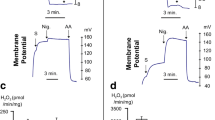Abstract
Oxidative stress is one of the major factors underlying mitochondrial dysfunctions. One of the most promising approaches for alleviating or preventing oxidative stress is the use of cationic uncouplers that accumulate in mitochondria in accordance to the level of the membrane potential, producing “mild” uncoupling. Based on this theoretical background, cationic rhodamine 19 butyl ester (C4R1) was synthesized and tested within the framework of the research project guided by V. P. Skulachev. The results of these tests were presented (Khailova et al. (2014) Biochim. Biophys. Acta, 1837, 1739-1747), but one publication could not accommodate all data on interactions of C4R1 with isolated mitochondria. In addition to previously presented data, we found that the effect of C4R1 on the rate of oxygen uptake is subject to temporal variations, which probably reflects variable rates of C4R1 entry into the mitochondria. Consequently, transient stimulation of respiration can be followed by inhibition. C4R1 was found not to shunt electron flow from complex I of the respiratory chain; it largely acted as an inhibitor of complex I in the respiratory chain and showed antioxidant activity. C4R1 taken at low, non-uncoupling concentrations enhanced the uncoupling activity of fatty acids (e.g. palmitate). Relatively low C4R1 concentrations stimulated opening of a nonspecific Ca2+/Pi-dependent pore. ATP synthesis and hydrolysis were substantially inhibited by C4R1 at low concentrations that had no appreciable effects on respiration in states 4 and 3 and only slightly decreased the membrane potential. Besides, conditions were revealed allowing correct evaluation of the membrane potential generated at the inner mitochondrial membrane with safranin O upon oxidation of both succinate and NAD-dependent substrates in the presence of C4R1.
Similar content being viewed by others
Abbreviations
- Ap5A:
-
P1,P5-di(adenosine-5′) pentaphosphate
- CsA:
-
cyclosporine A
- CCCP:
-
carbonyl cyanide 3-chlorophenyl-hydrazone
- C4R1:
-
rhodamine 19 butyl ester
- C12R1:
-
rhodamine 19 dodecyl ester
- DiSC3(5):
-
3,3′-dipropylthiadicarbocyanine iodide
- mPTP:
-
mitochondrial permeability transition pore
- ROS:
-
reactive oxygen species
- Δψ:
-
mitochondrial transmembrane potential
References
Korshunov, S. S., Skulachev, V. P., and Starkov, A. A. (1999) High protonic potential actuates a mechanism of production of reactive oxygen species in mitochondria, FEBS Lett., 416, 15–18.
Khailova, L. S., Silachev, D. N., Rokitskaya, T. I., Avetisyan, A. V., Lyamsaev, K. G., Severina, I. I., Il’yasova, T. M., Gulyaev, M. V., Dedukhova, V. I., Trendeleva, T. A., Plotnikov, E. Y., Zvyagilskaya, R. A., Chernyak, B. V., Zorov, D. B., Antonenko, Y. N., and Skulachev, V. P. (2014) A short-chain alkyl derivative of rhodamine 19 acts as a mild uncoupler of mitochondria and a neuroprotector, Biochim. Biophys. Acta, 1837, 1739–1747.
Chance, B., and Williams, G. R. (1955) A simple and rapid assay of oxidative phosphorylation, Nature, 175, 1120–1121.
Akerman, K. E., and Wikstrom, M. K. (1976) Safranine as a probe of the mitochondrial membrane potential, FEBS Lett., 68, 191–197.
Bernardi, P., Krauskopf, A., Basso, E., Petronilli, V., Blachly-Dyson, E., Di Lisa, F., and Forte, M. A. (2006) The mitochondrial permeability transition from in vitro artifact to disease target, FEBS J., 273, 2077–2099.
Zharova, T. V., and Vinogradov, A. D. (2006) Energy-linked binding of Pi is required for continuous steady-state protontranslocating ATP hydrolysis catalyzed by FoF1-ATP synthase, Biochemistry, 45, 14552–14558.
Bradford, M. M. (1976) A rapid and sensitive method for the quantitation of microgram quantities of protein utilizing the principle of protein–dye binding, Anal. Biochem., 72, 248–254.
Skulachev, V. P., Antonenko, Yu. N., Cherepanov, D. A., Chernyak, B. V., Khailova, L. S., Korshunova, G. A., Lyamzaev, K. G., Roginsky, V. A., Rokitskaya, T. I., Severin, F. F., Severina, I. I., Simonyan, R. A., Skulachev, M. V., Sumbatian, N. V., Sukhanova, E. I., Tashlitsky, V. N., Trendeleva, T. A., Vyssokikh, M. Yu., and Zvyagilskaya, R. A. (2010) Prevention of cardiolipin oxidation and fatty acid cycling as two antioxidant mechanisms of cationic derivatives of plastoquinone (SkQs) (review), Biochim. Biophys. Acta, 1797, 878–889.
Sukhanova, E. I., Trendeleva, T. A., and Zvyagilskaya, R. A. (2010) Interaction of yeast mitochondria with fatty acids and mitochondria targeted lipophilic cations, Biochemistry (Moscow), 75, 139–144.
Author information
Authors and Affiliations
Corresponding author
Additional information
Published in Russian in Biokhimiya, 2016, Vol. 81, No. 4, pp. 585-592.
Rights and permissions
About this article
Cite this article
Rogov, A.G., Trendeleva, T.A., Aliverdieva, D.A. et al. More about interactions of rhodamine 19 butyl ester with rat liver mitochondria. Biochemistry Moscow 81, 432–438 (2016). https://doi.org/10.1134/S0006297916040155
Received:
Accepted:
Published:
Issue Date:
DOI: https://doi.org/10.1134/S0006297916040155




